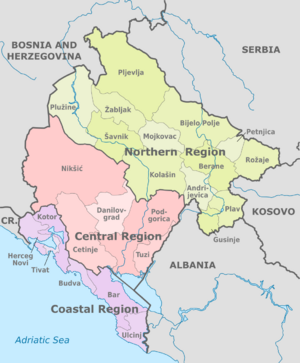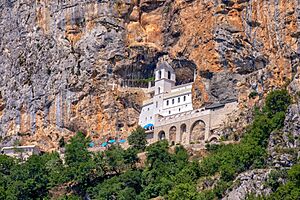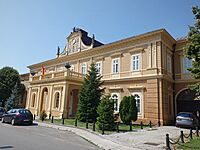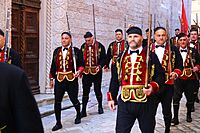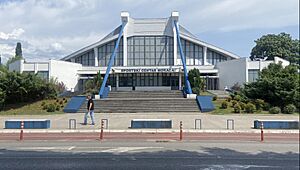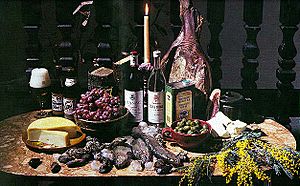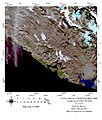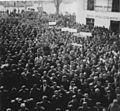Montenegro facts for kids
Quick facts for kids
Montenegro
|
|
|---|---|
|
Anthem:
Oj, svijetla majska zoro (English: "Oh, Bright Dawn of May") |
|
![Location of Montenegro (green)on the European continent (dark grey) — [Legend]](/images/thumb/b/b0/Europe-Montenegro.svg/350px-Europe-Montenegro.svg.png)
Location of Montenegro (green)
on the European continent (dark grey) — [Legend] |
|
| Capital and largest city
|
Podgorica 42°47′N 19°28′E / 42.783°N 19.467°E |
| Official languages | Montenegrin |
| Languages in official use | |
| Ethnic groups
(2023)
|
|
| Religion
(2023)
|
|
| Demonym(s) | Montenegrin |
| Government | Unitary parliamentary republic |
| Jakov Milatović | |
| Milojko Spajić | |
|
• President of the Parliament
|
Andrija Mandić |
| Legislature | Parliament |
| Establishment history | |
|
• Duklja
|
10th century |
|
• Zeta
|
1356 |
|
• Prince-Bishopric of Montenegro
|
1516 |
| 13 March 1852 | |
| 13 July 1878 | |
| 28 August 1910 | |
| 26 November 1918 | |
| 29 November 1945 | |
| 27 April 1992 | |
|
• Independence referendum
|
21 May 2006 |
| Area | |
|
• Total
|
13,812 km2 (5,333 sq mi) (156th) |
|
• Water (%)
|
2.6 |
| Population | |
|
• 2023 census
|
|
|
• Density
|
43.6/km2 (112.9/sq mi) (177th) |
| GDP (PPP) | 2023 estimate |
|
• Total
|
|
|
• Per capita
|
|
| GDP (nominal) | 2023 estimate |
|
• Total
|
|
|
• Per capita
|
|
| Gini (2020) | ▼ 32.9 medium |
| HDI (2022) | very high · 50th |
| Currency | Euro (€)a (EUR) |
| Time zone | UTC+1 (CET) |
|
• Summer (DST)
|
UTC+2 (CEST) |
| Calling code | +382 |
| ISO 3166 code | ME |
| Internet TLD | .me |
|
|
Montenegro is a country in Southeastern Europe, on the Balkan Peninsula. Its 25 municipalities have a total population of 633,158 people in an area of 13,812 km2 (5,333 sq mi). It is bordered by Bosnia and Herzegovina to the northwest, Serbia to the northeast, Kosovo to the east, Albania to the southeast, Croatia to the west, and has a coastline along the Adriatic Sea to the southwest. The capital and largest city is Podgorica, while Cetinje is the Old Royal Capital and cultural centre.
It is a member of the United Nations, NATO, the World Trade Organization, the Organization for Security and Co-operation in Europe, the Council of Europe, and the Central European Free Trade Agreement. Montenegro is also a founding member of the Union for the Mediterranean, and has been in the process of joining the European Union since 2012.
Contents
History
Before the arrival of the Slav peoples in the Balkans in the 6th and 7th centuries CE, the area now known as Montenegro was inhabited principally by people known as Illyrians. During the Early Medieval period, three principalities were located on the territory of modern-day Montenegro: Duklja, roughly corresponding to the southern half; Travunia, the west; and Rascia proper, the north. The Principality of Zeta emerged in the 14th and 15th centuries. From the late 14th century to the late 18th century, large parts of southern Montenegro were ruled by the Venetian Republic and incorporated into Venetian Albania. The name Montenegro was first used to refer to the country in the late 15th century. After falling under Ottoman Empire rule, Montenegro gained semi-autonomy in 1696 under the rule of the House of Petrović-Njegoš, first as a theocracy and later as a secular principality. Montenegro's independence was recognised by the Great Powers at the Congress of Berlin in 1878.
In 1910, the country became a kingdom. After World War I, the kingdom became part of Yugoslavia. Following the breakup of Yugoslavia, the republics of Serbia and Montenegro together proclaimed a federation. In June 2006 Montenegro declared its independence from Serbia and Montenegro following an independence referendum, creating Montenegro and Serbia as they exist today.
Geography
Internationally, Montenegro borders Croatia, Bosnia and Herzegovina, Serbia, Kosovo, and Albania. It lies between latitudes 41° and 44°N, and longitudes 18° and 21°E.
Montenegro ranges from high peaks along its borders with Serbia, Kosovo, and Albania, a segment of the Karst of the western Balkan Peninsula, to a narrow coastal plain that is only 1.5 to 6 kilometres (1 to 4 miles) wide. The plain stops abruptly in the north, where Mount Lovćen and Mount Orjen plunge into the inlet of the Bay of Kotor.
Montenegro's large karst region lies generally at elevations of 1,000 metres (3,280 ft) above sea level; some parts, however, rise to 2,000 m (6,560 ft), such as Mount Orjen (1,894 m or 6,214 ft), the highest massif among the coastal limestone ranges. The Zeta River valley, at an elevation of 500 m (1,600 ft), is the lowest segment.
The mountains of Montenegro include some of the most rugged terrain in Europe, averaging more than 2,000 metres (6,600 feet) in elevation. One of the country's notable peaks is Bobotov Kuk in the Durmitor mountains, which reaches a height of 2,522 m (8,274 ft). Owing to the hyperhumid climate on their western sides, the Montenegrin mountain ranges were among the most ice-eroded parts of the Balkan Peninsula during the last glacial period.
- Longest beach: Velika Plaža, Ulcinj – 13,000 m (8.1 mi)
- Highest peak: Zla Kolata, Prokletije at 2,535 m (8,317 ft)
- Largest lake: Skadar Lake – 391 km2 (151 sq mi) of surface area
- Deepest canyon: Tara River Canyon – 1,300 m (4,300 ft)
- Biggest bay: Bay of Kotor
- Deepest cave: Iron Deep 1,169 m (3,835 ft), exploring started in 2012, now more than 3,000 m (9,800 ft) long
Biodiversity
The diversity of the geological base, landscape, climate, and soil, and the position of Montenegro on the Balkan Peninsula and Adriatic Sea, created the conditions for high biological diversity, putting Montenegro among the "hot-spots" of European and world biodiversity. The number of species per area unit index in Montenegro is 0.837, which is the highest index recorded in any European country.
- Biodiversity outlook
- Freshwater algae of Montenegro – so far 1,200 species and varieties have been described.
- The vascular flora of Montenegro has 3,250 species. The number of endemics is also high – there are 392 Balkan (regional) endemic species, equivalent to over 7% of Montenegrin flora.
- There are 354 species of marine molluscs in Montenegro.
- Lake Skadar is among the most important habitats of freshwater fish, with 40 species, including species that migrate from marine to freshwater ecosystems, such as the eel (Anguilla anguilla) and shad (Alossa falax nilotica).
- The diversity of marine fish fauna of the Adriatic Sea includes 117 recorded families, but with a low level of endemism. To date, 40,742 marine fish species have been recorded in Montenegro, which represent 70% of the species recorded in the Mediterranean.
- Currently, 56 species (18 amphibian and 38 reptile) and 69 subspecies are recorded within 38 genera, and the list is probably incomplete. The mountain regions of Lovćen and Prokletije are particular hot spots for amphibians and reptiles.
- Of 526 European bird species, 333 are assumed to be regularly present in Montenegro. Of these, 204 species nest in the country.
Politics
Montenegro is a parliamentary representative democratic republic.
The President of Montenegro is the representative head of state, elected for a period of five years through direct election. The President promotes the country internationally through diplomatic engagements, promulgates laws by ordinance, calls elections for the Parliament, and ceremonially proposes candidates for Prime Minister, president and justices of the Constitutional Court to the Parliament. The President also ceremonially proposes the calling of a referendum to Parliament, grants amnesty for criminal offences prescribed by the national law, confers decoration and awards and performs other constitutional duties and is a member of the Supreme Defence Council. The official residence of the President is in Cetinje.
The Government of Montenegro is the executive branch of government authority of Montenegro and led by the Prime Minister. The role of Prime Minister is the most politically powerful office in Montenegro.
The Parliament of Montenegro is the country's unicameral legislature, located in Podgorica. The Parliament has power to appoint the government, pass legislation (parliamentary law) and scrutinise bills (proposed parliamentary law). It also appoints justices of all courts, approves the budget and performs other duties as established by the country's Constitution. Parliament can pass a motion of no confidence in the Government by simple majority vote. One member of the Montenegrin parliament, known as a Deputy, is elected per 6,000 voters. There are currently 81 deputies. Elections to the Parliament are conducted by the D'Hondt method, a form of proportional representation.
Administrative divisions
Montenegro is divided into twenty-five municipalities (opština). Each municipality can contain multiple cities and towns. Historically, the territory of the country was divided into nahije and during the beginning of SR Montenegro was divided into counties (srez).
Regions of Montenegro—designed for statistical purposes by the Statistical Office—have no administrative function.
- Northern Region
| Municipality | Area | Population | ||
|---|---|---|---|---|
| Km² | Rank | Total | Rank | |
| Andrijevica | 283 | 12 | 5,117 | 10 |
| Berane | 544 | 6 | 28,305 | 3 |
| Bijelo Polje | 924 | 2 | 46,676 | 1 |
| Gusinje | 486 | 8 | 13,108 | 6 |
| Kolašin | 897 | 3 | 8,420 | 8 |
| Mojkovac | 367 | 11 | 8,669 | 7 |
| Petnjica | 173 | 13 | 6,686 | 9 |
| Plav | 486 | 7 | 13,549 | 5 |
| Plužine | 854 | 4 | 3,286 | 12 |
| Pljevlja | 1,346 | 1 | 31,060 | 2 |
| Rožaje | 432 | 10 | 23,312 | 4 |
| Šavnik | 553 | 5 | 2,077 | 13 |
| Žabljak | 445 | 9 | 3,599 | 11 |
- Central Region
| Municipality | Area | Population | ||
|---|---|---|---|---|
| Km² | Rank | Total | Rank | |
| Cetinje | 899 | 3 | 16,757 | 4 |
| Danilovgrad | 501 | 4 | 17,678 | 3 |
| Nikšić | 2,065 | 1 | 72,824 | 2 |
| Podgorica | 1,399 | 2 | 187,085 | 1 |
| Tuzi | 236 | 5 | 12,096 | 5 |
- Coastal Region
| Municipality | Area | Population | ||
|---|---|---|---|---|
| Km² | Rank | Total | Rank | |
| Bar | 598 | 1 | 42,368 | 1 |
| Budva | 122 | 5 | 19,170 | 5 |
| Herceg Novi | 235 | 4 | 30,992 | 2 |
| Kotor | 335 | 2 | 22,799 | 3 |
| Tivat | 46 | 6 | 14,111 | 6 |
| Ulcinj | 255 | 3 | 20,265 | 4 |
Economy
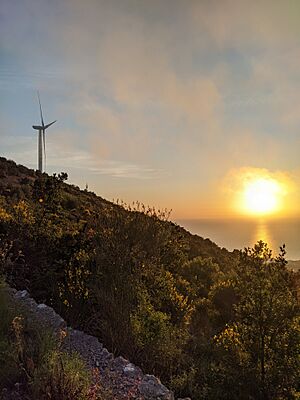
The economy of Montenegro is mostly service-based and is in late transition to a market economy.
A total of 2.1 million visitors visited Montenegro in 2022 spending 12.4m nights there. The majority of foreign visitors to Montenegro come from the neighbouring countries of Serbia, Bosnia and Herzegovina and Kosovo, as well as Russia.
The Montenegrin Adriatic coast is 295 km (183 mi) long, with 72 km (45 mi) of beaches and many well-preserved ancient towns. Some of the most popular beaches include Jaz Beach, Mogren Beach, Bečići Beach, Sveti Stefan Beach and Velika Plaža. Meanwhile, some of the most popular ancient towns include Herceg Novi, Perast, Kotor, Budva and Ulcinj.
Demographics
The 2023 census reported 623,633 citizens. Montenegro is a multiethnic state with no ethnic majority. Montenegrins make up 41.1% of the population, Serbs 32.9%, Bosniaks 9.45%, Albanians 4.99%, and Russians 2.01%. There is a significant number of other ethnic groups, including Romani people, Croats, Ukrainians, Belarusians, and Turks.
Montenegro is one of 22 countries with a GHI score of less than 5.
Languages
The official language in Montenegro is Montenegrin. Serbian, Bosnian, Albanian, and Croatian are recognised in official usage. Montenegrin, Serbian, Bosnian, and Croatian are mutually intelligible as standard varieties of the Serbo-Croatian language. Serbian is the most spoken language in the country, as a plurality of the population at 43.18% consider it as their native language, while 34.52% speaks the Montenegrin language. There is also singificant number of people speaking Bosnian (6.98%), Albanian (5.25%), and Russian (2.36%).
Religion
Eastern Orthodox Christianity is the predominant religion in Montenegro, with 71.1% of the population adhering to the religion. The second largest religion is Islam, practiced by 19% of the population. Montenegro has one of the highest proportion of Muslims in Europe. A little more than one-fourth of the country's Albanians are Catholics (8,126 in the 2003 census) while the rest (22,267) are mainly Sunni Muslims.
Culture
Montenegrin culture has been shaped most importantly by Orthodox, Ottoman (Turk), Slavic, Central European, and seafaring Adriatic cultures (notably parts of Italy, like the Republic of Venice).
Montenegro has many significant cultural and historical sites, including heritage sites from the pre-Romanesque, Gothic and Baroque periods. The Montenegrin coastal region is known for its religious monuments, including the Cathedral of Saint Tryphon in Kotor (Cattaro under the Venetians), the basilica of St. Luke (over 800 years), Our Lady of the Rocks (Škrpjela), the Savina Monastery and others. Medieval monasteries contain many artistically important frescoes.
One cultural dimension is the ethical ideal of Čojstvo i Junaštvo, "Humaneness and Gallantry". The traditional folk dance of the Montenegrins is the Oro, the "eagle dance" that involves dancing in circles with couples alternating in the centre, and is finished by forming a human pyramid of dancers standing on each other's shoulders.
Sport
Sport in Montenegro revolves mostly around team sports, such as water polo, football, basketball, handball, and volleyball. Other sports involved are boxing, tennis, swimming, judo, karate, athletics, table tennis, and chess.
Water polo is the most popular and is considered the national sport. Montenegro men's national water polo team is one of the world's top ranked teams, winning the gold medal at the 2008 Men's European Water Polo Championship in Málaga, Spain, and winning the gold medal at the 2009 FINA Men's Water Polo World League, held in Podgorica. The Montenegrin team PVK Primorac from Kotor became a champion of Europe at the LEN Euroleague 2009 in Rijeka, Croatia. Montenegro came fourth in the men's water polo in the 2016 Olympics.
Football is the second most popular sport. The Montenegro national football team, founded in 2006, played in playoffs for UEFA Euro 2012, its highest play appearance. The Montenegro national basketball team is known for good performances and won a lot of medals as part of the Yugoslavia national basketball team. In 2006, the Basketball Federation of Montenegro along with this team joined the International Basketball Federation (FIBA) on its own, following the Independence. Montenegro participated in two EuroBaskets.
Among women sports, the national handball team is the most successful, winning the country's first Olympic medal, claiming silver at the 2012 Summer Olympics. This was followed by the 2012 European Championship which Montenegro won, becoming European champions. ŽRK Budućnost Podgorica has twice won the EHF Champions League. Montenegro was one of the host countries for the 2022 European Women's Handball Championship and came third.
Cuisine
The first major influences to Montenegrin cuisine came from the Levant and Turkey: sarma, musaka, pilav, pita, gibanica, burek, ćevapi, kebab, đuveč, and Turkish sweets such as baklava and tulumba. Hungarian cuisine influences stews and sataraš. While Central European cuisine is evident in the prevalence of crêpes, doughnuts, jams, many types of biscuits and cakes, and various kinds of breads. Montenegrin cuisine also varies geographically; with the cuisine in the coastal area differing from that of the northern highland region. The coastal area is traditionally a representative of Mediterranean cuisine, with seafood being a common dish. The traditional dishes of Montenegro's Adriatic coast, unlike its heartland, have been significantly influenced by Italian cuisine.
Related pages
Images for kids
-
Zla Kolata, highest point of Montenegro
-
The Eurasian brown bear, a protected species in Montenegro.
-
The common bottlenose dolphin is often seen in the Bay of Kotor.
-
Royal family of Montenegro: King Nicholas I with his wife, sons, daughters, grandchildren and sons- and daughters-in-law
-
Captured ships of the Yugoslav Navy, Bay of Kotor 1941
-
Opening of Belgrade–Bar railway. Construction of the line started in the 1950s and completed in 1976. The line was opened in 1976 by the Yugoslavian President Josip Broz Tito
-
Map of the disintegration of Yugoslavia until 2008
-
The controversial 2019 law on religious communities, introduced by the former ruling DPS, proposed the transfer of the majority of religious objects and land owned by the largest religious organization in the country, the SPC, to the Montenegrin state. It sparked a series of massive protests across the country, which led to the first government change in the country's history.
See also
 In Spanish: Montenegro para niños
In Spanish: Montenegro para niños




